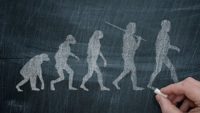07/30/19 ‘The origin of species is exactly what Darwin cannot explain’ David Gelernter, a famed Yale University professor, has publicly renounced his belief in Charles Darwin’s theory of evolution, calling it a “beautiful idea” that has been effectively disproved. Gelernter, who is known for predicting the World Wide Web and has developed many complex computing tools over the years, is today a professor of computer science at Yale, chief scientist at Mirror Worlds Technologies, member of the National Council of the Arts, and a prolific author. In May, the Claremont Review of Books published a column [More]
How reliable are the conclusions of historical science compared to experimental science? …read more Source: creation.com
By Dr. Terry Mortenson Creationists and evolutionists look at the same fossil and genetic evidence, but they interpret it very differently because of different starting assumptions. …read more Source: AIG Daily
It’s an ‘out there’ concept that doesn’t help to explain why we are down here. Read More
Nobody saw her “billions of years of research and development”, yet ‘she’ is credited with nature’s marvels of engineering. Read More
The dynamic process of fish schooling is amazingly preserved in a ‘Fossilized freeze frame’ recording their coordinated collective motion. …read more Source: creation.com
Creation-based thinking made a testable prediction. If Noah’s Flood formed dinosaur and other fossils only 4,500 or so years ago, then they may still contain measurable amounts of the short-lived radioactive isotope carbon-14—also called radiocarbon. On the other hand, any fossil deposited before the limit of carbon-14 longevity (around 100,000 theoretical years ago) would have no carbon-14 left. Now, a team of secular scientist… More… …read more Source: icr.org
By Ken Ham Creationists were shocked to read a news article about the evolution of lilies—astonishingly, a fossilized lily, the supposed oldest ever discovered (115 million years), looked just like. . . a lily! The evolution is incredible! Actually, it forgot to evolve! Okay, so that was very tongue-in-cheek—we weren’t surprised to see that lilies have always been lilies. That’s exactly what we’d expect based on God’s Word. This particular specimen was “extraordinarily well preserved,” including roots, flower, and even the individual cells. And it has all the features of that specific class of plant (monocotyledonous): “parallel-veined, …read more Source: [More]
By Troy Lacey Researchers studying mole-rats and the East African root rat discovered that several had pain insensitivity to different irritants (referred to as “algogens”). …read more Source: AIG Daily
By Dr. Jason Lisle Unfortunately, many Christians have bought into the idea of extraterrestrial “alien” life without critically assessing such a belief in light of Scripture. …read more Source: AIG Daily
By Harry F. Sanders, III A recent tweet asserted, “Evolution has been directly observed both in the lab and in the field. If you had done any research whatsoever, you would know this.” …read more Source: AIG Daily
In 2005, biologists were stunned to discover that humans might not all look the same to honeybees. A study has found that bees can learn to recognize human faces in photos, and remember them for at least two days.1 Twelve years later, Science magazine published an article describing the “unprecedented cognitive flexibility” of bees using a ball to get a reward.2 Biologist Loukola said, More… …read more Source: icr.org
How does Noah’s Flood provide a better framework for understanding unconformities? …read more Source: creation.com
The Smithsonian Institution in Washington D. C. just finished a five-year renovation of its dinosaur hall at a cost of around $110 million.1 The renovated exhibit opened to the public on June 8, 2019. Naturally, the television news segment made the usual references to “millions of years” and the supposed evolutionary history of life on Earth. The most interesting aspect of the news story was a large m… More… …read more Source: icr.org
By Tom Hennigan Nature isn’t all peace and beauty. But even the dark side of creation can tell us something about God’s grace. …read more Source: AIG Daily
When the peacock vibrates its colourful fan of tail feathers, the ‘eyespots’ behave differently from the rest of the feathery background, leaving the peahen mesmerized. Read More
Lubrication in a dusty environment can be a problem, so engineers have turned to the sandfish skink lizard for a solution. Read More
By Troy Lacey It was assumed the Antarctic blackfin icefish’s clear blood adapted to a cold water environment. A new study reveals just how radical this “adaptation” is. …read more Source: AIG Daily
The little appendage that can cause a lot of pain and confusion. …read more Source: creation.com
Evolutionary theory is based on the faulty assumption that chance random processes can produce highly ordered complex systems, and this theory routinely fails to reveal scientific reality. A new secular study that applies engineering principles in the analysis of spider-web physics, related to the design concept of “power amplification,” has not only been highly successful, but also glorifies the amazing genius of God the Creator.More… …read more Source: icr.org
By Ken Ham I’ve written about a lot of strange things on this blog, but I never thought gender-fluid tomatoes—from Australia, my home country, no less—would be one of them. But that’s where our culture has ended up—having a discussion about how a strange plant, a species of bush tomato from the Outback, somehow shows that the “sexual binary” is “a fallacy.” Various reproductive strategies are God’s designs to help organisms continue to reproduce, ensuring the survival of their kind, in an ever-changing fallen world. The researchers, however, go further than just describing the plant and naming it Solanum plastisexum. [More]
Evolution of bones in middle ear in mammals unheard of. …read more Source: creation.com
Is the fine-tuning of the universe evidence for divine design? …read more Source: creation.com
Could DNA building blocks have formed in a primordial soup? How to think about chemical evolution papers. Read More
How can we understand the mysterious Denisovan people from a biblical perspective? …read more Source: creation.com
By Dr. Gordon Wilson It was recently discovered that double-stranded microRNA (miRNAs) fed to honey bees conferred resistance to certain viral diseases that they were exposed to. …read more Source: AIG Daily









































